Girls from KNOL design borrowed some AdMoVeo‘s to serve salt and pepper for their food design activities , and have been on omroep brabant last saturday.
http://www.youtube.com/watch?v=gJxNon2clro
Girls from KNOL design borrowed some AdMoVeo‘s to serve salt and pepper for their food design activities , and have been on omroep brabant last saturday.
http://www.youtube.com/watch?v=gJxNon2clro
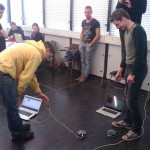
Yesterday I managed a one-day workshop on dichotomies in designing distributed systems, for 25 master students in the class “Designing for Systems”. The dichotomies addressed were standalone/distributed, centralized control/decentralized control, and process-/product-oriented design, as well as a hidden agenda for the conflicts between standards and implementations. In this workshop I wanted the student to “experience” the dichotomies Instead of me telling the story.
Two types of distributed systems were focused on, client/server and peer to peer. Students were divided into four groups, one working on C/S, two on P2P and another on standardization of data and communication. They are briefed and quickly pushed into hands-on work to make a few AdMoVeo robots to dance together, in a distributed setting.
The workshop worked out quite well in terms of its designed goals, and actually it was beyond my expectations – I did not expect that robots would really dance together, but at the end of the day, all the teams managed to show something, at least partially working. One of the other things surprised me was the difficulties they had in creating and parsing XML documents, which was suggested for saving time from standardizing the data and message formats. I could have made some partially working code snippets to reduce the load.
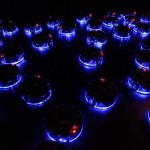 Tom’s Guide published an article by Paul Escallier, in which the AdMoVeo is featured as one of the “30 Inventions From Regular Guys”. We are happy to see that AdMoVeo is getting more attention, although we are listed as “regular guys” 🙂
Tom’s Guide published an article by Paul Escallier, in which the AdMoVeo is featured as one of the “30 Inventions From Regular Guys”. We are happy to see that AdMoVeo is getting more attention, although we are listed as “regular guys” 🙂
Read the part about AdMoveo or you may want to have a look at all these inventions.
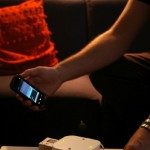
For the EU project SOFIA (Smart Objects For Intelligent Applications), Bram van der Vlist and Gerrit Niezen created a demonstrator for one of the use cases: semantic connections. “The demonstrator consists of a set of devices; surround sound-set, mobile mp3 players, an ambient lighting system and interaction device(s). The interaction device is a tile-like interactive object that allows for both exploration of the Smart Space in terms of connections and manipulation of these connections and information/data streams. Coloured LED lighting and light dynamics visualize the connections and connection possibilities between the various devices. By means of putting devices close to one of the four sides of the tile, a user can check if there is a connection and if not if a connection is possible. By simply picking up the tile, and shaking it a user can make or break the connection between the devices present at the interaction tile.”
http://www.youtube.com/watch?v=vdZcjqfq8RQ
Nice research done by our Master student Niels Molenaar: Would highlighting the clean seats and darkening the litter in a train let people feel the train is cleaner? The answer is No. To know more about this research, read his report:
LightAndThePerceptionOfCleanliness (PDF, 379KB)
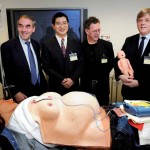 17 december 2009 – Er is veel kraamvisite, veelal gewapend met camera’s, aanwezig bij de geboorte van Medsim op donderdag 10 december. Medsim is niet zomaar een baby; het is het eerste bevallingssimulatiecentrum ter wereld. De trainingsruimtes zijn gevestigd op twee verdiepingen in Kennispoort en minister Maria van der Hoeven kwam het lintje, in de vorm van een buikwand, doorknippen. De TU/e is niet alleen verhuurder van de locatie, ze levert ook de nodige techniek. [Read more: HTML, PDF]
17 december 2009 – Er is veel kraamvisite, veelal gewapend met camera’s, aanwezig bij de geboorte van Medsim op donderdag 10 december. Medsim is niet zomaar een baby; het is het eerste bevallingssimulatiecentrum ter wereld. De trainingsruimtes zijn gevestigd op twee verdiepingen in Kennispoort en minister Maria van der Hoeven kwam het lintje, in de vorm van een buikwand, doorknippen. De TU/e is niet alleen verhuurder van de locatie, ze levert ook de nodige techniek. [Read more: HTML, PDF]
by Sophie van der Weerd, [PDF | 2M]
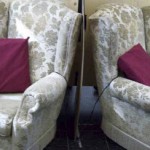
In her B22 project report, Sophie writes: “…I will offer the ‘WeTouch Pillow’; the pillow that communicates your families’ presence in a subtle way without an obliged effort. If one uses his pillow, the pillow of the other becomes warmer and vice versa. I will focus upon the communication tools market. The market will have a need for my product, since it communicates family presence without an obligation and current communication tools require an obligation and effort, which people do not like when communicating with their family like having to call, as to my user research. I want to express to the market the importance of family presence and contact, but that there is no obliged effort needed. The internet will be a good medium to use to contact the target group of relatives living apart, since the younger generations uses it a lot. And I try to reach people who live apart from each other, so an internet service which sends one pillow to each of the relatives is a good way to sell the WeTouch Pillow. Also because an internet connection is needed for the pillows to connect…”
Final Bachelor Project by Ruben Hekkens. Report: [PDF, 4M]
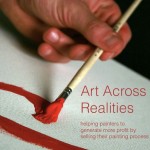
Final USI project by Li Li. Report: [PDF, 1.8M]
The Collaboratory software system at FEI Company allows customers to work together with an electron microscope over a distance, and to share the instruments, microscopy expertise and services. It originally has been developed from the results of the Collaboratory.nl project.
Continue reading Collaboratory: working together over a distance